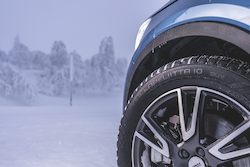When it comes to winter conditions, most people will use tires made only for the winter season, i.e., winter and snow tires. They are available both as studded winter tires and non-studded winter tires. They both use different methods to give you the ultimate performance in severe winter conditions. They use a specialized tread and rubber compound, and they don’t have to compromise for other seasons. The tires can therefore be optimized especially for snow and ice at low and freezing temperatures. When you use studded tires, you will have an additional grip on ice, as the studs are able to dig into the ice. Different states and provinces in the United States have different laws regarding the use of winter tires, so it’s essential to look into the laws concerning the state or province where you live.
Depending on the location where you live, there will be a difference for when you have to change to winter tires. Some states will have winter starting already in October and will therefore allow for earlier dates when the winter tires can be used. Others will have a later onset of winter, and the dates will be later. The best timing to change to winter tires is when the temperature drops to near freezing. You should always have winter tires on your vehicle when you have snow on the ground and you attempt to drive.
The special rubber compound of winter tires can stay soft even in cold weather. Winter tires improve traction, braking and handling. However, the big drawback with seasonal tires is that you have to change tires between the seasons. Winter tires shouldn’t be used during other seasons than the cold winter season. When it comes to non-studded tires, there are no restrictions for their use during the summer season, but the wear will be high, and you won’t have the optimal performance. It is not allowed to use Studded tires during the summer season, and you have to abide by the date restrictions that are in force related to their use.
When equipping your car with winter tires, the winter tires must be mounted before the snow arrives to maintain control and stability of your vehicle. It is also important that you have a similar grip on all four tires. They should all be of the same brand and have similar tread depth. Whether you purchased studded or non-studded tires, both options will be able to handle the toughest winter conditions. If you live in an area with severe winters, you will not be disappointed by their performance. Suppose you are not willing to change over to winter tires in the winter. In that case, all-weather tires can be considered as they also have a severe service emblem on the sidewall of the tires, signifying that they have passed the tests and can therefore be used in severe winter conditions. If the area where you live has mild winters, then maybe even an all-weather tire would suffice.
For more information regarding winter and snow tires, visit: https://www.nokiantires.com/
